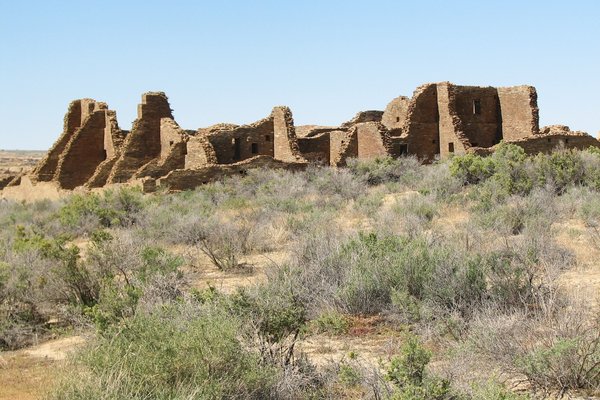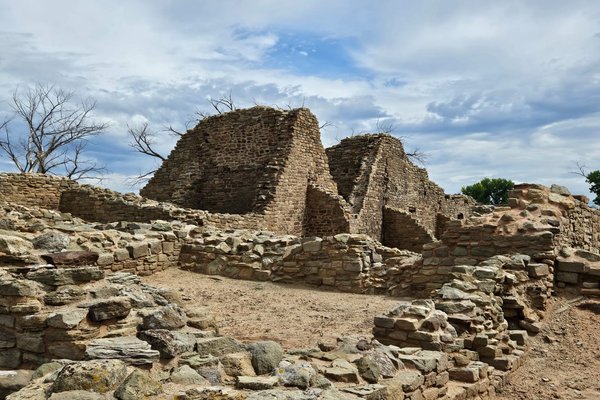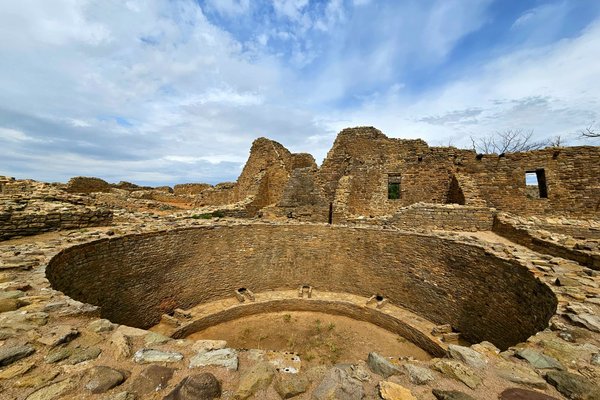United States of America
Chaco Culture
Chaco Culture is an archeological site illustrating the architectural and engineering achievements of the Pre-Columbian Chaco people.
The Chaco were the ancestors of the modern Pueblo peoples. They lived in this harsh environment from the 9th to the 13th centuries and created agricultural communities and a road network. The great houses (public buildings) of Pueblo Bonito, Una Vida, Hungo Pavi and many more were constructed. The site includes Chaco Culture National Historical Park, the associated sites at Aztec Ruins National Monument, and five additional protected archaeological areas.
Community Perspective: Chaco Culture NHP is quite a remote site and accessible by a gravel road only. A visit takes multiple hours and you can even stay overnight (camping, reservation advised). Kyle and Michael report on visits to some of the associated sites such as Aztec Ruins.
Site Info
Official Information
- Full Name
- Chaco Culture (ID: 353)
- Country
- United States of America
- Status
-
Inscribed 1987
Site history
History of Chaco Culture
- 2006: Name change
- From "Chaco Culture National Historical Park" to "Chaco Culture"
- 1987: Inscribed
- Inscribed
- 1985: Deferred
- Already have Mesa Verde - Chaco originalilty is its road system - but this isn't within the site
- Type
- Cultural
- Criteria
- iii
Links
- UNESCO
- whc.unesco.org
- Official
-
- nps.gov — National Park Service
- Related
-
- en.wikipedia.org — Wikipedia on Chaco Culture National Historical Park
All Links
UNESCO.org
- whc.unesco.org — whc.unesco.org/
Official Website
- nps.gov — National Park Service
Related Resources
- en.wikipedia.org — Wikipedia on Chaco Culture National Historical Park
News Article
- May 11, 2025 cherokeephoenix.org — Ancient DNA confirms New Mexico tribe's link to famed Chaco Canyon site
- June 3, 2023 reuters.com — US bans new oil and gas leasing around New Mexico cultural site
- May 23, 2018 seattletimes.com — Tribes, senators seek buffer around world heritage site
- Sept. 24, 2017 denverpost.com — Archaeologists: More protections needed for Chaco region in New Mexico
- June 24, 2015 westerndigs.org — Bones of Exotic Macaws Reveal Early Rise of Trade, Hierarchy in Chaco Canyon
- March 15, 2015 rt.com — Fracking will ruin sacred, preserved sites in Chaco Culture National Historic Park
- Aug. 23, 2007 gallupindependent.com — Chaco spared from bite of drill bits: The initial plans by Cimarex Energy to drill two natural gas wells on state land within the Chaco Culture National Historical Park have been put on hold by the company.
Community Information
- Community Category
- Archaeological site: Pre-Columbian
Travel Information
Recent Connections
-
On Coins
America the Beautiful Quarters, 2012See…
-
Archaeological Site Reburial
The 2013 Periodic Report stated - "The …
-
Threatened by Oil and Gas Exploration
"Energy exploration and extraction, sp…
Connections of Chaco Culture
- Geography
-
-
Colorado River Basin
Chaco River - San Juan River - Colorado River -
Dark-sky preserve
Chaco Culture National Historical Park
-
- Trivia
-
-
On Coins
America the Beautiful Quarters, 2012See en.wikipedia.org
-
Preservation assisted by Getty Trust
Chaco Canyon (1991-6)
-
- History
-
-
Pueblo culture
Between AD 900 and 1150, Chaco Canyon was a major center of culture for the Ancestral Puebloans. (wiki) -
Archaeological 'Type Sites'
Basketmaker III Culture. In 1927 "Frank H. H. Roberts excavated the pithouse village called Shabik'eschee. This site pre-dated the period of the construction of Chacoan great houses (monumental public buildings), and became the archaeological "type-site" (example) for the Basketmaker III period in the Pecos classification of Pueblo cultures"... "it is located on the lowest terrace of a finger of Chacra Mesa at the east end of the current Chaco Culture National Historical Park." Pueblo Bonito "is the type site for the Bonito phase (about A.D. 860 to 1140)"
-
- Damaged
-
-
Threatened by Oil and Gas Exploration
"Energy exploration and extraction, specifically oil and gas production currently threatens viewshed and the assocciated cultural landscape" (Periodic Reporting 2013) and "On November 15, 2021, the Interior Department placed a 2-year pause of new oil and natural gas leasing on federal lands within a 10-mile buffer zone of Chaco Canyon." (see link).See www.forbes.com
-
- World Heritage Process
-
-
Inscribed on a single criterion only
iii. to bear a unique or at least exceptional testimony to a cultural tradition or to a civilization which is living or which has disappeared
-
- Human Activity
- WHS on Other Lists
-
-
World Monuments Watch (past)
(1996)
-
- Timeline
-
-
Built in the 11th century
The zenith of this culture was from 1020 to 1100
-
- Science and Technology
-
-
Astronomy and Astrology
Pueblo Bonito - layout and astronomical petroglyphs
-
- Visiting conditions
-
-
Archaeological Site Reburial
The 2013 Periodic Report stated - "The 1989 plan called for backfilling, or reburial of certain portions of the standing architecture to promote long term preservation". See this article for a description of the "Rebusial progam" at Chaco sites and a discussion of pros and cons for the reurial approach.
See www.nps.gov
-
- WHS Names
-
-
Name changes
From "Chaco Culture National Historical Park" to "Chaco Culture" (2006)
-
News
- cherokeephoenix.org 05/11/2025
- Ancient DNA confirms New Mexico tr…
- reuters.com 06/03/2023
- US bans new oil and gas leasing ar…
- seattletimes.com 05/23/2018
- Tribes, senators seek buffer aroun…
Recent Visitors
Visitors of Chaco Culture
- Alejandro Lau
- Alexander Lehmann
- Alex Baranda
- Alex Goh
- AmyAbroad
- Ana
- Anna Wludarska
- Antonio J.
- Argo
- Artsybrea
- Atila Ege
- AYB
- Bin
- Bluewonder310
- Brendan Carroll
- Brett Baumann
- brornt
- ChrisN
- Cluckily
- Colossus
- cophbulls
- Csaba Nováczky
- Dagmara
- Daniela Hohmann
- Daniel R-F
- dave wood
- David Aaronson
- David Berlanda
- debatecoach
- Dolemite92
- Don Irwin
- Dorejd
- DouglasR
- Els Slots
- Errol Neo
- Fan Yibo
- Filip Murlak
- Frederik Dawson
- Gary Arndt
- George Gdanski
- GeorgeIng61
- Grendel Gongan
- Hdhuntphotography
- hegeline@icloud.com
- Iain Jackson
- Ian Cade
- IreneKD
- Jacob Choi
- Jacob Otten
- Jakob F.
- Janina Lehmann
- Jarek Pokrzywnicki
- Jason Boulette
- Javier Coro
- Jay T
- Jeanne OGrady
- Jens
- Joel on the Road
- KarenBMoore
- Kasia M.
- kayakka
- Kedp2023
- KeithBailey
- Kelly Rogers
- Kevin McFarland
- Kim, Soo-youn
- kjluebke
- Kurt Lauer
- Kyle Magnuson
- Lara Adler
- leroykstlj
- Lillybett
- Ludvan
- Luis Filipe Gaspar
- maryhattie
- Matthewsharris
- Michael Ayers
- MichaelH
- Michael Novins
- Mihai Dascalu
- MMM
- Monica Tasciotti
- Mstrebl1990
- Naim Y
- Nicolas
- Nicole Lampos
- Nihal Ege
- opperpco3
- Peter Lööv
- Pink Bunny
- Rachel Perkins
- Ralf Regele
- Randi Thomsen
- Roel Sterken
- Roger Ourset
- Roman Bruehwiler
- Samy G
- Schnitzel
- Shandos Cleaver
- Solivagant
- Stan
- Stefan Loov
- Svein Elias
- Thomas Buechler
- Thomas van der Walt
- Thorben
- Tim Allen
- Timothy C Easton
- Tommy W
- tony0001
- triath
- Tsunami
- Vanessa Buechler
- Vincent Cheung
- Walter
- WILLIAM RICH
- Xiquinho Silva
- Yi Han Goh
- ZCTLife
- Zoe
- Zoë Sheng
Community Reviews
Show full reviews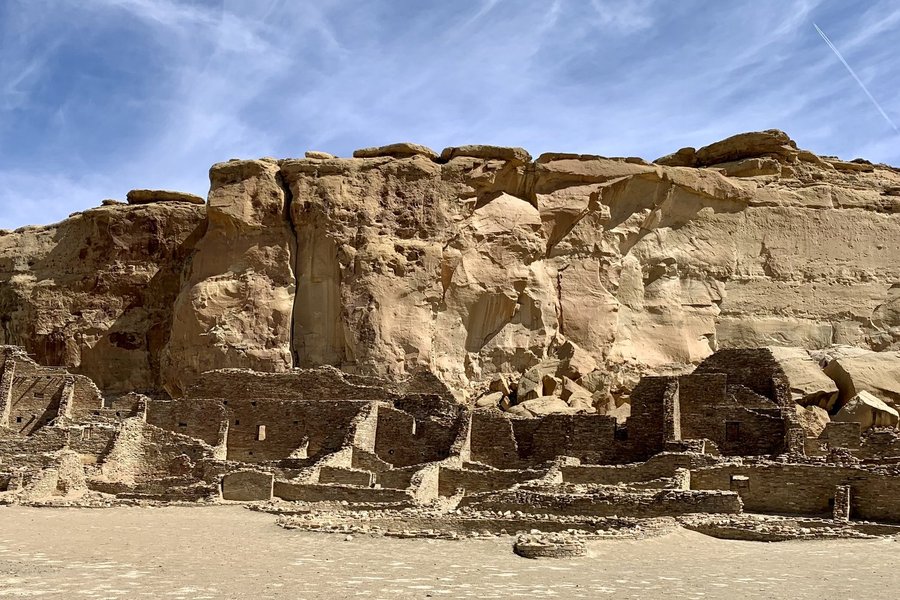
Chaco Culture was one of my first destinations on my quest to visit all the national park units in the US in my zero carbon emission vehicle. While a WHS visitor could just visit Aztec Ruins, my ZCT.Life quest requires me to visit both sites. Since I was driving through Navajo Nation from Gallup to Farmington where the chargers are, the park entrance from the south requires 33 miles of dirt roads before driving out northeast on 16 miles more dirt roads, plus 125 miles of paved road for the whole trip. I visited in 2022, and I didn’t realize that driving on heavily washboarded dirt roads would use up so much range and time. Even driving very slowly, I think I lost 2 miles of range for every mile I drove. The site is still sacred to the Navajo Nation and other native tribes, so I suppose the road conditions help keep the site remote.
Chaco Culture is not at all like the misnamed Aztec Ruins (that have nothing to do with the Aztecs). Chaco is huge; its ancient roads and irrigation are studied from space. The major sites are spread out over 10 miles, so you will see ruins on the top of bluffs miles away. The largest complex of buildings sits at the base of a cliff, which partially collapsed in 1941, so the place is inseparable from the dramatic natural landscape. Unlike Aztec Ruins which has an exceptionally beautifully restored kiva, Chaco’s kivas and other buildings …
Keep reading 0 comments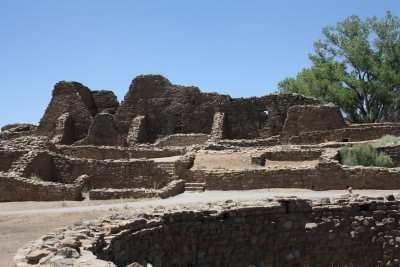
June 2012 -we were primarily trying to visit nationalparks on our trip, so we did not drive much south into New Mexico. However we visited Aztec ruins NM, which also belongs to the WHS. Quite interesting excavations, Museum and possibility to enter all houses. It was a nice stopover before going back to Colorado, where we still visited the great Wild Western Town of Durango. We vben drove further to Mesa Verde that day, so it is all in rather short distance from each other.
Keep reading 0 comments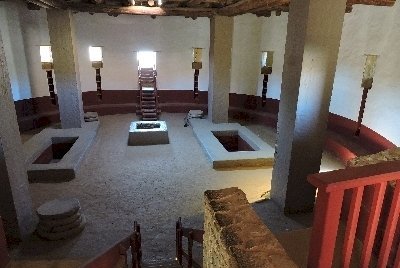
Visit in April 2019.
I will add another review for this WHS because I included a stop at Aztec Ruins National Monument, which has not been covered previously. The Monument is located within the relatively pleasant town of Aztec, New Mexico (both usages of the name “Aztec” are acknowledged misnomers,) and so would make an easy visit for a traveler who wants to learn something about the interesting Chaco Culture and visit this WHS.
This Monument contains one good example of a Great House in the Chacoan style which is somewhat smaller than Pueblo Bonito in Chaco Canyon, but similar in size to Pueblo del Arroyo, or Chetro Ketl, also in the Canyon. Overall, the site is in fine condition, and some of the rooms still have their original wooden ceilings. The main Kiva was restored in the early 20th century so that its interior now resembles what it is thought that the original structure looked like. This modern restoration was probably not perfectly authentic, but I found it quite interesting to see, and have used it as the photo for this review. Whether a visit to this site alone would suffice to claim a visit to the WHS as a whole, should be left up to individual travelers, but in my opinion, it could.
However, I continued on to the main location of this WHS, Chaco Canyon National Historical Park, as well, and I will add a few points relating to getting there by bicycling. The …
Keep reading 0 comments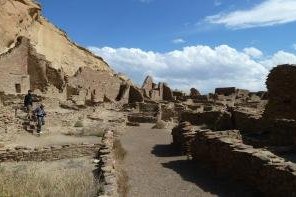
I’ll admit it; this was the site in the South West that I was visiting purely because I was in the area rather than because I had a strong desire to see it. Well I’m happy to report giving it such a low billing was entirely wrong, the magnificent ruins here were a distinct highlight of the region.
I wasn’t expecting the ruins to be so extensive, so large or of such eminence; the brick work really is astounding. The quality of the remains far out-strips even the high points of Mesa Verde, reflecting that this canyon was the centre of a civilisation as testified by it being the hub of a unique road system. Like Els, we picked up the really handy booklets at the start of each trail which provided a wealth of information.
The distinct highlight was Pueblo Bonito, which is a complex hive of rooms and inter-locking kivas. There was something so compelling about the settlement; it was endlessly intriguing trying to puzzle out the relationship between the different structures. And being able to duck off and get lost in the maze of rooms really brought out the little boy in me. Though this was the highlight, the other groups of ruins were also well worth the time to explore and the trails of Petroglyphs bought yet another aspect to this wonderful site.
We spent the night before our visit at the little ‘town’ of Cuba in the friendly Frontier Motel (if you want an authentic …
Keep reading 0 comments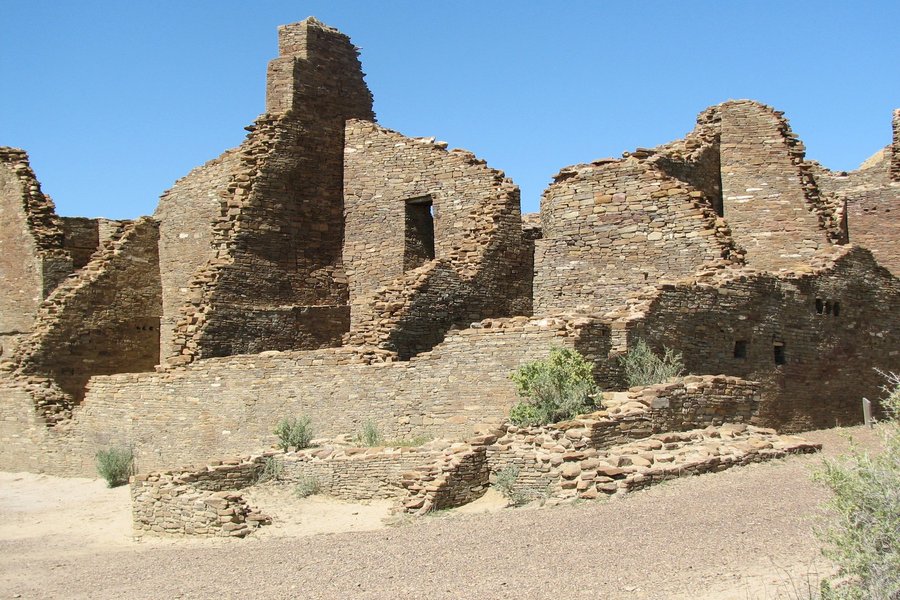
Chaco Canyon (CC) is one of those sites that could take a life-time of research, interviews, reading, and visiting to even begin to comprehend. Learning just a bit will remind you of how little you knew about this WHS previous to that.
Engage in lots of reading and studying prior to a visit. Find someone who knows something about the area and pick their brains beforehand. There is so much to see, but you have to know what to look for and where it is located.
To that end, go to the Visitor Center and get a back-country hiking pass. The car loop does not really let you see what is there. Get a good park map, and hike (where it is legal to do so, of course).
I also highly recommend the book "Anasazi" by Frank McNitt. It is in print through University of New Mexico Press. It is the biography of Richard Wetherill. Opinion is extremely divided as to his legacy, as most anything to do with Southwestern archaeology usually is. However, I think the professionals' dim view of his work stems mainly from jealousy. Wetherill tended to get their first because he was willing to take the risks. The academics back East waited for him to do the locating...that's my interpretation at least.
Take plenty of water and food. There is not a whole lot out there. European visitors need to be especially aware of this. This is not like hiking in the Cotswolds, or from one …
Keep reading 0 comments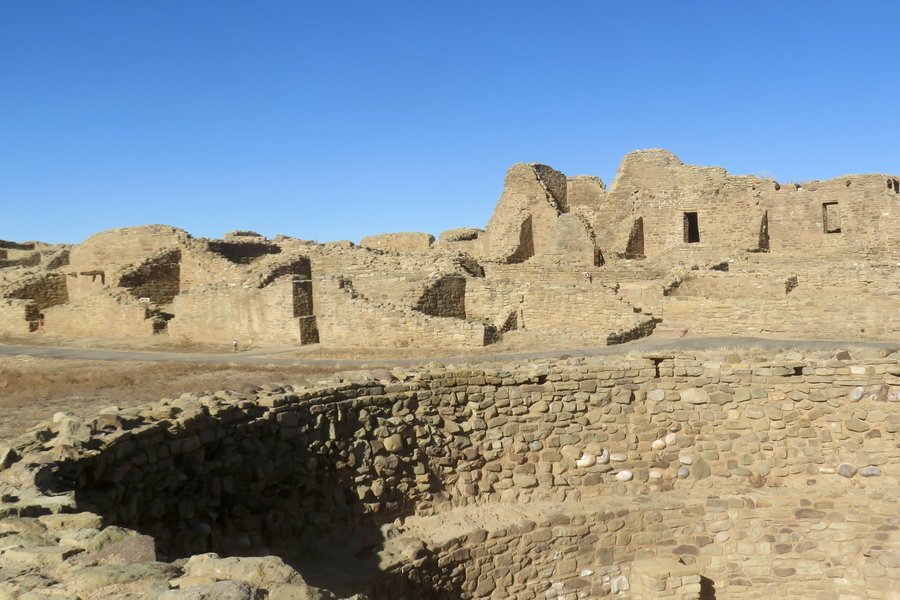
Chaco is one of many great archaeological sites scattered throughout the Southwest, though what makes it exceptional is the culture that emerged here and flourished over centuries. Chaco Culture is inscribed on a single criteria: (iii) to bear a unique or at least exceptional testimony to a cultural tradition or to a civilization which is living or which has disappeared. The diverse native traditions and histories today in the region do not necessarily perceive the Chacoan culture as "disappeared" and in fact view sites at Chaco Canyon, Mesa Verde, and other cultural sites as interconnected to the stories and living traditions of their people today.
I thoroughly enjoyed my visit here in May 2010 and to the Aztec Ruins component in November 2022. The complex of sites of "Chaco Culture National Historical Park" are large and spread out within the canyon. Half a day is appropriate to see all the sights. The exceptional passageways, doors, and kivas are some of the best preserved anywhere in the Southwest.
Aztec National Monument is not too far away and it's certainly worth your time. As the other essential component to the Chaco Culture world heritage site, the Aztec Ruins located near the Animas River operated as a regional center that may have flourished even after the great Chacoan houses to the South declined. There are only a few 'other" visitable components (besides Chaco Canyon/Aztec Ruins) for keen travellers seeking a complete experience. Pueblo Pintado or Kinteel "wide house" which is located 16 …
Keep reading 0 comments
Previous reviews have thorough historical information about Chaco Culture, so I will focus on logistics and what not to miss. I went with a group of five plus our wonderful tour guide, Mo, out of Santa Fe. It is a 3-hour drive from the city and very much worth it. I enjoyed hiking at Una Vida, particularly to see some very clear petroglyphs. Chetro Ketl and Pueblo Bonito were my favorite sites, particularly the latter because of our park tour guide who took us through there. He was very knowledgeable about Chaco and had been working at the park for 10 years. What drew him to the area was the gathering of fellow astronomers, who gaze at the clear night sky because there's no light pollution.
It can get very hot at Chaco Culture. I was happy that Mo told us to bring a light long-sleeved shirt to protect us from the sun. If you plan to travel from Santa Fe, I highly recommend going with Mo's tour group. You can find more information at www.swadventures.com. I wouldn't drive to Chaco myself, especially on the washboard road from the highway leading into the park. Also make time for the gift shop, as it has wonderful books and other high quality souvenirs. Beside the gift shop is a small museum, which is also worth a visit. I especially liked the diorama it had of what Chaco Culture could have looked liked when it was inhabited. It gave me a clearer idea …
Keep reading 0 comments
I lived at the Pueblo Alto Trading Post (Run by a man named Tanner who flew a Cessna 175 in and out of the area from Farmington) in 1967-68. I played football with a group of missionaries in what was then called the Chaco Canyon's Ruins (we actually played in the wash on the sand).
At that time we say what appeared to be mearly inches of what must have been tops of walls at that sight.
I do remember that up higher on the north side, there was a ledge so to speak - where a huge water basin was shaped out of the rock (approx 15-25 ft wide by no more than 4-8 ft deep. If you remember this "oddity" we are talking about the same sight.
Keep reading 0 comments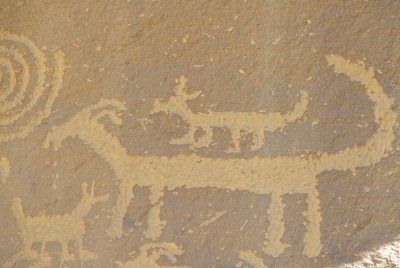
The route from Sante Fe to Chaco Culture National Historical Park is easy. First the I-25 south, and then Highway 550 at Bernalillo. The 550 is another long road with not much to see. From the well-posted highway exit, it takes another 21 miles, 14 of them on a dirt road. It's really remote out here, I wonder if there are other tourists around. After about 45 minutes of bumping up and down, I arrive at the Visitor Center. A few other people clearly have made it out here too, as there are already some cars in the parking lot. At an entrance fee of 8 dollars per car, you can take a roundtrip of 9 miles through the valley and along the points of interest. The impressive Fajada Butte marks the entrance to the park.
But I start with the short walk to Una Vida. This is a mostly unexcavated great house. It's the most eastern of all public buildings in this region, that were connected by a road network. I pick up a booklet at the start of the walk which points out the most remarkable features. The walk has a length of 1.6 miles and is a very enjoyable one in a relatively chilly morning. The highlight for me is the group of petroglyphs you can see on the rock just above the house.
I drive on to the next stop: Hungo Pavi. Here the walls are in a good condition. The Chaco were very …
Keep reading 0 comments
This is a wonderful place to visit, full of gorgeous vistas, hiking opportunities, and many chances to just sit back and think about what a structure like this means.
As I remember, the gravel road we took to get to Chaco was long and bumpy, but not outrageous. They have a nice visitor's center that explains a lot of the history of the area and Chaco itself.
Bring water with you - and a camera and journal. I would love to return and camp there - to witness Chaco at night would be amazing!
Keep reading 0 comments
I'm told road from the North is better; porpoising washboard road on reservation includes sudden drops that _can_ have a cow in them for omigod entertainment. Note wide shallow dams to channel rare fierce floods from mesa to fields. P. Bonito's later construc. tells us where Mesa Verde folk went during drought c. 1200 a.d. & trade goods, e.g. bright feathers, show connection to Aztecans. Bring food, water & hiking togs, devour info for sale there. A Valhalla for digger anthropologists. Amazing that thousands could live here; an outstanding study in sustainability.
Keep reading 0 comments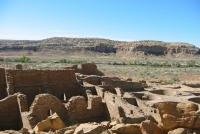
The Chaco Culture National Historical was the last World Heritage Site I visited on my recent trip to the Southwest. Although it is not far from several decently-sized cities and towns, it gives the impression of being quite remote. This is underscored by the fact that entering the park requires driving on 16 miles of rough gravel road. Although a road map makes this seem like a relatively short distance from the highway, realistically it takes rather a long time because one can't drive particularly fast on this very bumpy road (the road is paved once you enter the actual park). The park gets very warm in the summer and there is little shade.
The park features a large collection of ancestral puebloan ruins, including the massive Pueblo Bonito. This structure is believed to have been four stories high and contained over 600 rooms and 40 kivas (ceremonial round rooms). Pueblo Bonito was easily accessible from the main road in the park and the guided tour was very informative. More challenging trails to other sites in the park require a permit, and since we were only camping at the park for one night, we didn't have time to go.
A wonderful extra benefit to visiting the Chaco Culture site is that it has very dark skies, due in part to the park's active commitment to reducing light pollution. This makes it very popular with the local astronomy community; in fact one local astronomer has donated a domed observatory and other …
Keep reading 0 comments
